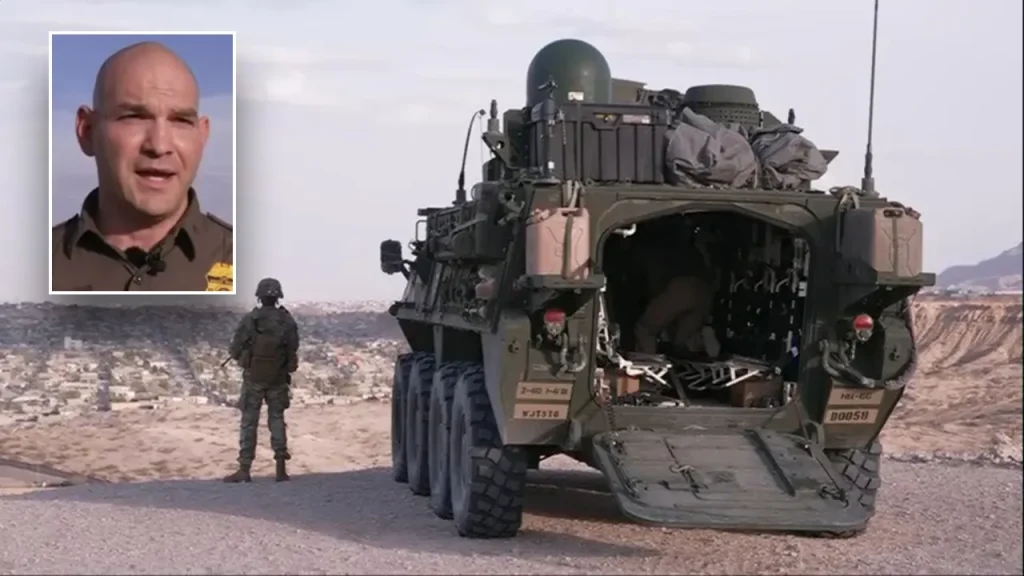EL PASO, Texas – In a notable development regarding border security, eight-wheeled armored fighting vehicles, known as Strykers, have been deployed to the U.S.-Mexico border for the first time in over a decade. This initiative is part of the Pentagon’s efforts to support Customs and Border Protection (CBP) in managing border security amidst ongoing challenges related to illegal immigration. Currently, two Strykers are stationed in the El Paso sector, with plans for further deployment across the border in the upcoming weeks, aiming to enhance surveillance operations.
| Article Subheadings |
|---|
| 1) Overview of Stryker Deployment |
| 2) The Role of Strykers in Border Patrol Operations |
| 3) Capabilities and Features of the Stryker Vehicles |
| 4) Impact on Migrant Encounters and Deterrence |
| 5) Future Implications for Border Security |
Overview of Stryker Deployment
The recent deployment of Stryker vehicles along the U.S.-Mexico border marks a significant transition in how military resources are utilized in domestic border security. Historically known for their battlefield applications, these armored vehicles are now being repurposed for surveillance and tactical support for the Border Patrol. As of the week of deployment, two Strykers have been positioned in the El Paso sector, with additional units expected to follow. The incorporation of military-grade equipment underscores a heightened response to illegal migration and the challenges faced by U.S. border enforcement.
The Role of Strykers in Border Patrol Operations
As the U.S. grapples with complex border dynamics, the adaptation of military resources like the Stryker shows an innovative approach to operational strategy. According to the U.S. Border Patrol, these vehicles will primarily assist agents in surveillance activities rather than engaging directly in combat situations. U.S. Army Sgt. Carlos Zamora noted that the vehicles enhance the surveillance capability of agents, allowing them to monitor the border with greater efficiency. Once illegal migrants are detected, agents can respond swiftly based on the information relayed by the Strykers.
Capabilities and Features of the Stryker Vehicles
The Stryker vehicles, while not equipped with weapons for this mission, offer advanced surveillance features crucial for border patrol activities. With infrared technology, these armored vehicles can detect movement up to two miles away during both day and night. This capability provides Border Patrol agents with a significant advantage in monitoring difficult terrains and identifying unauthorized crossing attempts. Furthermore, Lt. Colonel Chad Campbell highlighted that the Strykers are equipped with high-precision optics, allowing agents to gather critical intelligence, further enhancing their operational readiness.
Impact on Migrant Encounters and Deterrence
Since the arrival of the Strykers, Border Patrol operations have reported a striking decrease in migrant encounters. On a recent Thursday, agents in the El Paso sector noted only 32 encounters, a dramatic drop from 1,134 reported on the same day in the previous year. This significant reduction showcases the potential deterrent effect the Strykers have when visibly present at the border. As Hamid Nikseresht, a Special Operations Supervisor, indicated, the goal is to maintain low migrant encounter numbers. The psychological impact of the Strykers, conveying strength and capability, is believed to discourage potential crossers.
Future Implications for Border Security
The deployment of Strykers could potentially set a precedent for future military support in domestic law enforcement operations. While current numbers of illegal crossings are at historic lows, the utilization of military assets aims to ensure that these trends continue and do not revert to previous years’ highs. Both local law enforcement and military strategists are examining this collaboration closely, considering how military technology can be effectively integrated into civilian operations without overstepping boundaries related to the use of force. The long-term effects of such integrations remain to be seen as both potential benefits and challenges emerge during this evolving scenario.
| No. | Key Points |
|---|---|
| 1 | Strykers have been deployed to the U.S.-Mexico border for enhanced surveillance and support to Border Patrol. |
| 2 | The vehicles are utilized for surveillance, not direct combat, as they are unarmed in their current deployment. |
| 3 | Equipped with infrared technology, Strykers improve detection capabilities for illegal crossings. |
| 4 | The deployment has coincided with a significant reduction in migrant encounters in the El Paso sector. |
| 5 | Future deployments of military resources may redefine operational approaches in border security. |
Summary
The deployment of Stryker vehicles to the U.S.-Mexico border signifies a strategic shift in addressing illegal immigration and enhancing border security operations. By leveraging advanced military technology, officials aim to deter cross-border illicit activities while supporting Border Patrol’s ongoing efforts. With initial indicators suggesting a positive impact, the future of such deployments could shape how law enforcement collaborates with military assets in domestic contexts, ultimately striving for a balanced approach to border management.
Frequently Asked Questions
Question: What is the purpose of deploying Strykers to the border?
The primary purpose of deploying Strykers is to enhance surveillance and support Border Patrol agents in detecting illegal migrants, operating primarily as a deterrent rather than in a combat role.
Question: How do Strykers assist in surveillance operations?
Strykers are equipped with advanced infrared technology that allows them to detect movement up to two miles away, providing crucial intelligence to Border Patrol agents during their operations.
Question: What has been the impact on migrant encounters since the Strykers’ deployment?
There has been a significant decrease in migrant encounters, with reports showing only 32 encounters in a recent week compared to over a thousand in the same period last year, highlighting the potential deterrent effect of the Strykers.


